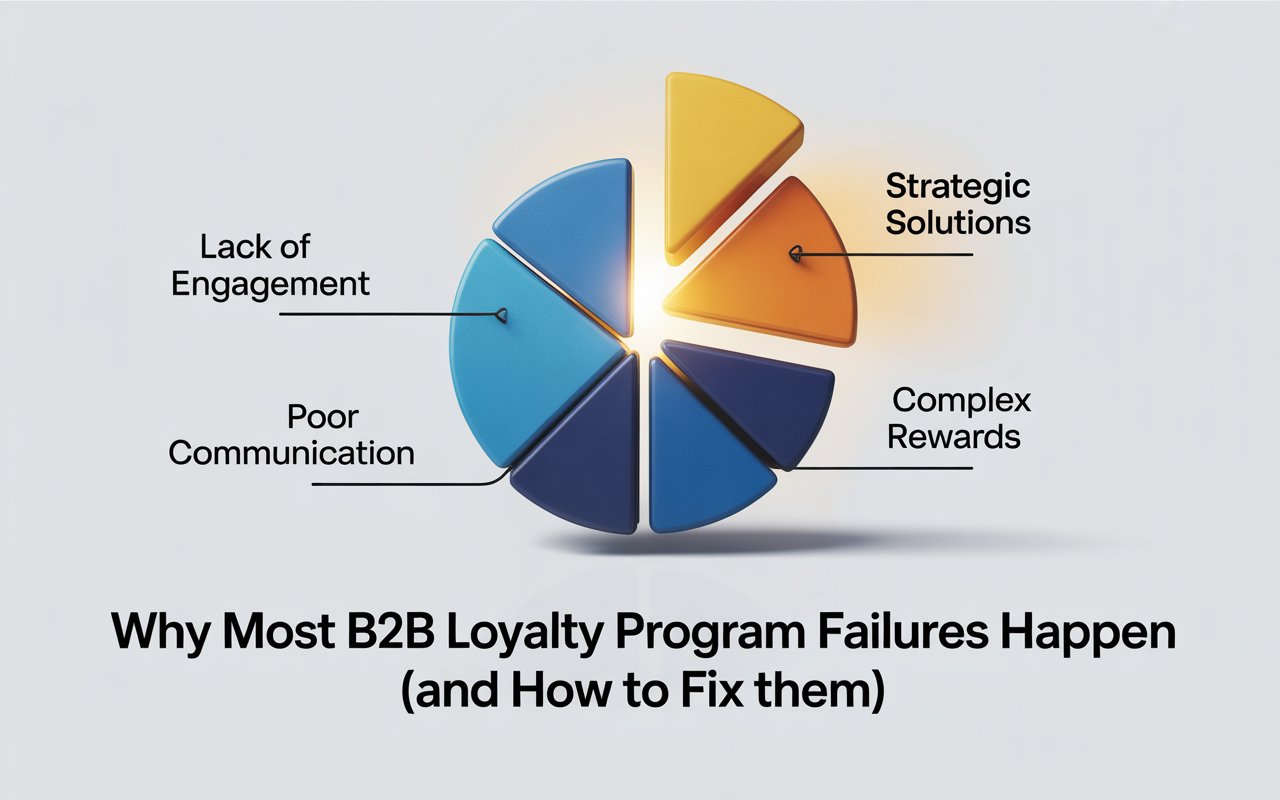Understanding B2B loyalty program failures is the first step to turning them into success stories. Most issues can be fixed with the right strategies and a focus on customer needs. By addressing the common mistakes and applying proven solutions, you can build a loyalty program that drives retention, boosts revenue, and strengthens relationships with your business clients.
While loyalty programs are meant to strengthen customer relationships, several recurring issues cause them to underperform or collapse. Understanding these issues will help you avoid making the same mistakes.
Common Reasons Behind B2B Loyalty Program Failures
While loyalty programs are meant to strengthen customer relationships, several recurring issues cause them to underperform or collapse. Understanding these issues will help you avoid making the same mistakes.
1. Lack of Clear and Measurable Objectives
Many loyalty programs are launched without a defined purpose. Businesses sometimes view them as a “nice to have” rather than a strategic growth tool. Without a clear objective — like increasing order frequency, expanding share of wallet, or improving client retention — it’s impossible to know if the program is successful. This lack of direction often results in wasted budgets and poor engagement.
2. Irrelevant or Low-Value Rewards
In B2B, rewards have to go beyond the standard consumer-style points and discounts. Offering rewards that don’t align with your clients’ operational needs leads to disengagement. For example, a wholesale distributor offering cinema tickets might seem generous, but it’s not relevant to a client’s business needs. Rewards should help customers save money, operate more efficiently, or gain a competitive advantage.
3. Weak Communication and Visibility
Even a well-designed program can fail if customers don’t know about it or forget it exists. Some companies launch with enthusiasm but fail to maintain regular updates, reminders, and promotional campaigns. If your clients aren’t reminded of the benefits and how to earn them, participation will naturally decline.
4. Complex Participation Rules
A lot of companies invest heavily in B2B loyalty programs hoping to build long-term customer relationships. Yet many of these programs fail to deliver the expected results. Sales don’t improve, engagement remains low, and customers lose interest. This often leads businesses to think loyalty programs don’t work at all — but the truth is, the way companies plan and manage them causes the problem.
When earning and redeeming rewards becomes complicated, customers lose interest. Complicated terms, hidden restrictions, or difficult redemption processes can frustrate participants and reduce engagement. Simplicity is key in building trust and long-term loyalty.
How to Fix Failing Loyalty Programs
If you’ve identified that your loyalty program is underperforming, don’t abandon it entirely. Instead, take a structured approach to fixing the gaps.
1. Redefine Program Goals
Go back to the drawing board and define specific, measurable goals. Instead of “make customers more loyal,” try “increase repeat purchases by 20% over the next quarter” or “raise average order value by 15% within six months.” Clear metrics make it easier to track performance and adjust accordingly.
2. Align Rewards with Customer Priorities
Talk to your customers or conduct surveys to understand what they truly value. In B2B markets, incentives could include bulk purchase discounts, exclusive product previews, enhanced support packages, or flexible payment terms. When rewards are tailored, engagement rises.
3. Improve Communication Strategy
Create a structured plan for informing your customers about the program. This could include regular email updates, account manager check-ins, and digital dashboards showing real-time points or benefits. Highlight new rewards and share success stories to inspire participation.
4. Simplify the Process
Reduce friction in earning and redeeming rewards. Use clear language, remove unnecessary rules, and allow multiple redemption options. The easier it is to participate, the more likely your customers will stay active in the program.
Best Practices for Long-Term Success
Once you’ve fixed the immediate issues, focus on building a program that can grow with your business.
1. Segment Your Customer Base
Not all clients are the same. A one-size-fits-all approach can alienate certain customer groups. By segmenting based on industry, purchase history, or engagement level, you can tailor rewards and communication for better results.
2. Leverage Data and Analytics
Track how customers interact with your program. Look at redemption rates, popular rewards, inactive participants, and overall program ROI. Data will guide you in making small, impactful changes rather than broad, costly adjustments.
3. Keep Innovating the Reward Mix
Business needs evolve, and so should your rewards. Review and refresh the program regularly to maintain interest. Seasonal offers, time-limited bonuses, or milestone rewards can keep engagement high.
4. Focus on Relationship Building
Loyalty programs should not just be about transactions. They are an opportunity to strengthen trust and partnership. Offering educational content, networking opportunities, or VIP access to company events can make the program feel more valuable and exclusive.
The Role of Continuous Improvement
Even a well-designed program needs regular updates to stay relevant. Trends change, customer needs evolve, and market conditions shift. By focusing on Improving B2B loyalty program outcomes through feedback and data analysis, you ensure your program remains valuable year after year.
Final Thoughts
B2B loyalty program failures are rarely the result of the concept itself — they usually stem from how the program is planned, executed, and maintained. By identifying the gaps, redefining your goals, aligning rewards with what your customers actually value, and keeping communication clear and consistent, you can turn an underperforming program into a growth-driving asset.
The companies that succeed are those that treat their loyalty programs as an ongoing commitment rather than a one-time campaign. Regular updates, customer feedback, and relevant rewards will keep your program fresh and meaningful.
With the right approach, your loyalty program won’t just retain customers — it will strengthen partnerships, increase revenue, and give your business a competitive edge in the market. The choice is simple: either let your program fade into the background or take the steps you need to make it a lasting success.
Is Your Loyalty Program Delivering The Results You Expected — Or Could It Be Performing Better?




